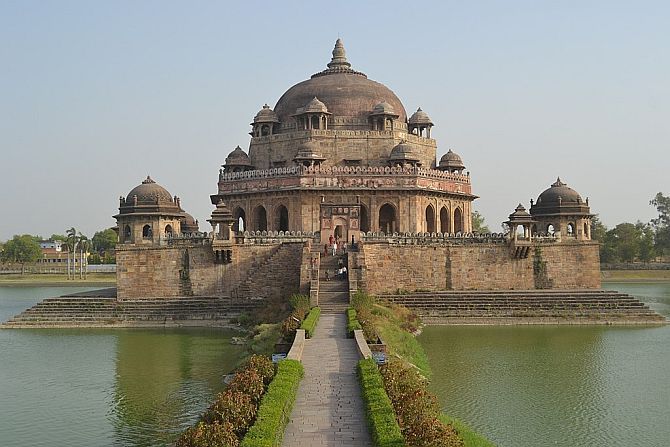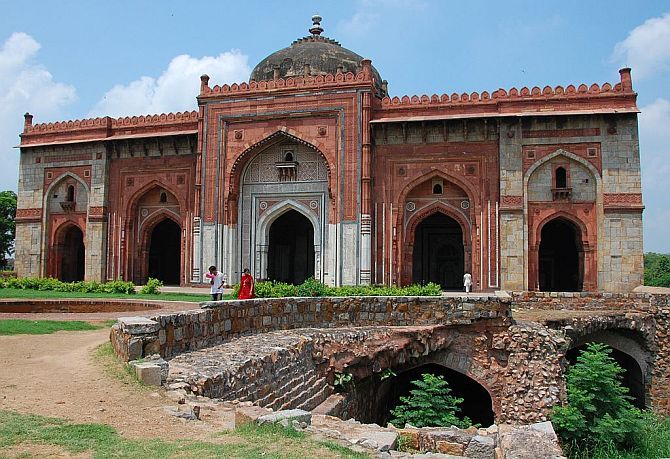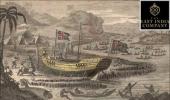Sher Shah Suri ruled for only a few years, but his huge influence on India continues six centuries later, reveals Farhat Nasreen.

Although Sher Shah's reign lasted only a few years, his impact on the administrative system of north India was lasting.
He dewaxed the sluggish and corrupt officials who robbed the government with one hand and the peasantry with the other.
The modalities of revenue assessment and collection were reformed.
He recommended that raids by the auditors of the revenue collectors' accounts should be surprise checks.
The relevant papers of the village should be seized by the auditors before the village headman was warned of such a raid.
His insistence on 'daagh-o-chehra' (branding of horses maintained by individuals and nobles and maintenance of descriptive rolls of soldiers) improved the efficiency of the army.
Officials were called to account for crimes in their areas and were personally obliged to compensate the victims.
Abbas Khan Sarwani informs that the duties of the village 'muqaddam' (headman) went far beyond the management of village finances.
He was held accountable for any crime that happened within his village or near it.
In cases of robbery or murder of travellers, he was obliged to produce the culprits and the goods stolen.
Irfan Habib calls it a 'rough and ready' system of maintaining law and order, which was continued by the Mughals.
Sher Shah also commissioned the construction of a network of roads to facilitate trade and commerce.
Trees were planted to keep them cool and dak khanas (post offices), 'serais' (motels) and 'thanas' (police check-posts) were made at regular intervals.
Free trade was opened between the various provinces of the empire.
He refined the coinage system and insisted on the purity of the coins produced from his mints.
His silver 'rupiya' continued as a standard coin for centuries after him.

Intermediaries who towed the line of Sher Shah's efficient and honest administration were retained, while those who were found to be habitually contumacious and repeat offenders were given exemplary punishments.
Habib informs us that when Sher Shah was managing his father's jagir in Bihar, the rebellious zamindars of that area were ruthlessly eliminated.
In fact, the foot-troopers of such zamindars, called the 'ganwaars' (local peasants), were also uprooted and completely new people were settled in such villages to smoothen the flow of obedience.
Leniency was shown at the time of assessment of tax, but no concessions were allowed at the time of collection.
Every city and fort was equipped with military supplies and treasures.
Land revenue assignments were granted to officers for a steady maintenance of troops which could be summoned to service with the royal forces.
However, money accorded to the nobility was no guarantee of a competent army.
Corrupt officials pocketed the funds allocated for the salary of regular soldiery and hired untrained people as and when necessity arose.
Ensuring that as many soldiers were on an officer's payroll as he claimed put the state's efficiency to test.
The rigorous implementation of daagh-o-chehra was the only way to check fraud and have a committed army.
Thus paraphernalia of officials like 'karkuns' (clerks), 'chihradars' (maintainers of the descriptive rolls), 'aspkhaanadars' (in charge of stables), 'pheeldaars' (in-charge of elephants), 'khazanadaars' (treasurers), 'toofangdaars' (matchlock men), 'kotwals' (officer-in-charge of law and order), 'shiqdaars' (officer in charge of a unit of administration) and 'munsifs' (judge of a unit of administration) etc were employed to work collectively towards good governance.
Officers like the Shiqdaar-i shiqdaaraan and Munsif-i munsifaan were appointed for a higher level of review of applications and of the work of officers of subordinate units.
Thus a bureaucracy with a reasonably neat system of hierarchy was put in place.
His reforms testified to his dexterity in administration and politics and many of his data and systems were retained and further refined by Akbar.
The Ain-i-Akbari records the initiation of the gaz-i Ilaahi unit of land measurement in 1586 and the unit used before that is recorded as the gaz-i Sikandari/Iskandari.
The latter name is associated with Sikandar Lodi (1489-1519), who had initiated the use of this unit of measurement.
However, some documents from Sher Shah's period mention another unit called the gaz-i Sher Shahi, which implies that Sher Shah had made enough changes in the gaz-i Sikandari/Iskandari for the unit to be given his name.
The crop rates fixed by Sher Shah have also been mentioned by Abul Fazl.
He states that the Sur ruler had brought Hindustan under the Zabt system of revenue management.
Rai (crop rates) were fixed for lands which were 'Polaj' (under continuous cultivation) or 'Parauti' (left fallow very rarely).
Rai was based on three rates, depending on the quantum of yield: Good, average or low.
An average of these was taken to arrive at a general rate of the produce, and a third of that amount was fixed as the tax.
In the initial year of Akbar's reign, Sher Shah's Rai rates were used to assess taxes.
Given the shortness of his reign, his contribution to architecture is also remarkable.
He built the Purana Qila, which was intended to be the sixth city of Delhi.
The architecture of the Qila-i Kuhna mosque (1542), which is located within the Purana Qila, is unique.
However, it is his tomb at Sasaram which is considered to be an architectural masterpiece.
It is set in a tank and can be approached by a causeway.
The tomb has five vertical stages and the design changes sharply at each stage.
The conception is absolutely free of the influence of any other building.
The anecdotes presented here highlight the ruler's pragmatic approach to administration and his zest for excellence.

Whenever possible, Sher Shah supervised the daagho-chehra personally and settled wages of old and new recruits.
On one such occasion a youth approached him, riding a high breed-horse and dressed chicly, he was a picture of flamboyance.
However, Sher Shah fixed a rather low remuneration for him.
Shaikh Khalil, a Sufi, interceded on the youth's behalf and said that he deserved a better salary.
To defend his decree the king asked the young man to draw his bow.
The fellow couldn't draw it far enough to shoot an arrow.
It implied that either he was too weak or out of practice, or he simply didn't know how to do it.
Nevertheless, the Sufi argued that the bow was possibly new and stiff, and that is why it could not be drawn properly.
In response, Sher Shah ordered his personal bow to be brought.
This one was soft due to regular use in practicing.
But the man failed to draw this one as well.
Now the Sufi interceded that his stifling and heavy suit of armour was an impediment to the test.
So the king generously allowed another trial without the suit, but he failed yet again.
Sher Shah concluded that military trials should be conducted with a view to establishing a candidate's ability and sincerity.
Not only did recruiting incompetent men compromise the cumulative strength of the army, the life of such men would be at greater risk than usual in the battlefield.
Well-dressed people, who were suave and deferential, could also turn out to be surprising failures.
He warned recruiters that outwardly charming and inwardly shallow men might be able to attract promiscuous women, but before granting a commission they should assess if the candidates were up to scratch, all cosmetic excesses notwithstanding.
Thus the king emphasized the idea that the suitability of a candidate is a very critical factor.
For example, beautiful looking lips are not essential for delivering a great talk -- however, they might be totally indispensible if one has to sell lipstick.

Official Records and Tools of Governance
Once, a soldier appeared before Sher Shah and tried to pass muster by cheating.
He was one amongst several temporary fillers hired by a noble to act as ghost soldiers.
The king picked up the soldier's sly vibes and inquired as to where and by whom had he been recruited.
The soldier lied that the king had mustered him himself at Manikpur.
The poor fellow was probably unaware that officers maintained detailed muster books, and therefore particulars of the Manikpur muster were, in fact, available.
So he was asked to furnish details about the date and name of the village where he was interviewed.
Obviously he failed, and begged the king's forgiveness.
He was promised amnesty if he disclosed the name of the official who had tutored him to lie.
Eventually, all the fraudulent enrollers were apprehended.
This particular man was forgiven and properly recruited as a soldier.
The deceit was plotted on the assumption that two years had passed since the monarch's Manikpur inspection, and therefore details for cross-referencing would not be available.
However, records were maintained and they had duplicates in Persian and Hindawi.
The man who gave two rupees to someone to act as a soldier and charged the government hundreds on the pretext of the soldier's salary could not get away with the trick, because someone else had done his homework, and done it well.
As noted before, Sher Shah recommended that the person sent to audit the accounts of the village officials (amils) should conduct a surprise raid so that the papers could not be changed or manipulated by the local revenue officials and the village headmen.
Medieval records refer to cases where the Kaaghaz-i asli/Kaaghaz-i khaam (original/old records of villages' revenue) were burnt and replaced with new manipulated papers to deceive auditors.

Once, when Sher Shah was deciding the selection of candidates for armed services, a rather naive young man appeared for the interview.
The monarch dismissed him, calling him a 'nobody' under his breath.
The poor fellow overheard him and asked the superintendent what pay a 'nobody' could expect.
The superintendent smiled at this and the king, having noticed that, asked him the reason for his smile.
When he was informed about the interviewee's enquiry, he couldn't help laughing.
Moved by the man's gullibility and innocence, he actually gave him employment.
So he loosened the straps of power whenever he could, and walked down the slant of the human side.
During one of his inspectorial visits, Sher Shah noticed that a rider looked conspicuously uncomfortable.
He asked the man to dismount from his horse.
Troubled by the order, the man fell off, awkward and inelegant.
The monarch enquired whether he was a soldier or just the groomer of the horse, because his posture indicated that he was not proficient at riding.
Scared out of his wits, he confessed that, in fact, he was only the 'charwadaar' (the one who feeds the horse) and had been paid by an official to pose as a regular cavalry man.
The perpetrator of the bogus presentation was punished, but the poor man was forgiven.
Thus Sher Shah discouraged slipshod surveying methods and was serious about weeding out the parasitic existence of unfair functionaries.
Enthusiasm was a key element in his style of management and a very potent catalyst, which mixed with his ability, produced energy -- positive energy.
Excerpted from If History Has Taught Us Anything by Farhat Nasreen, with the kind permission of the publishers, Rupa Publications India.










